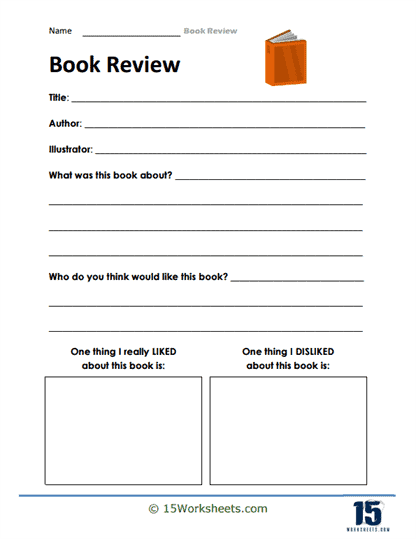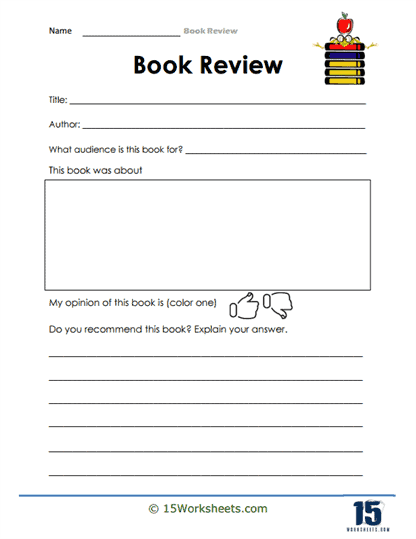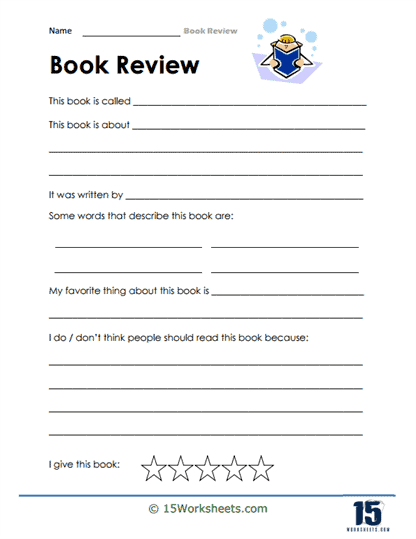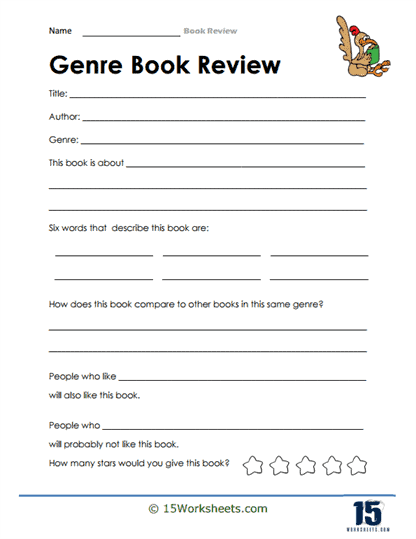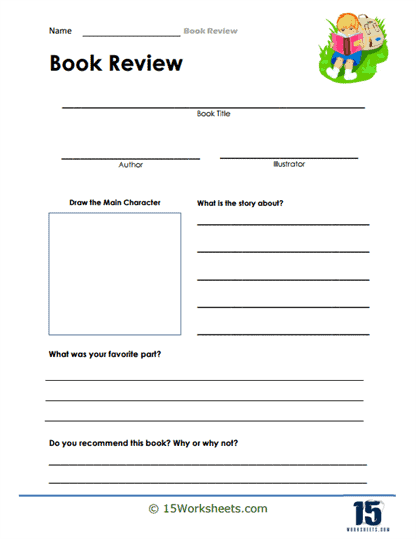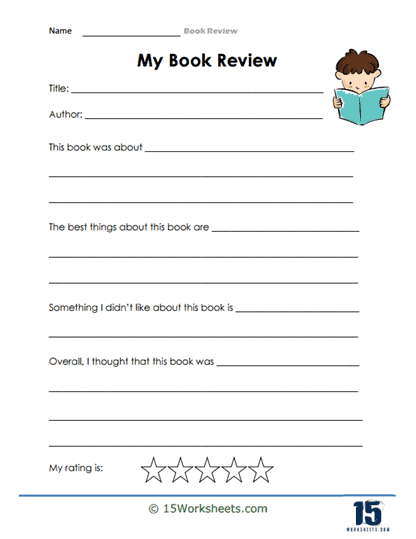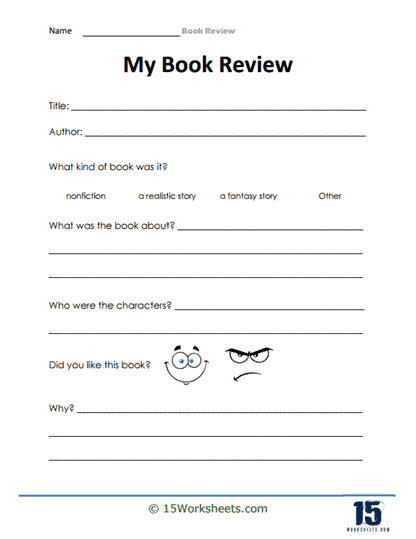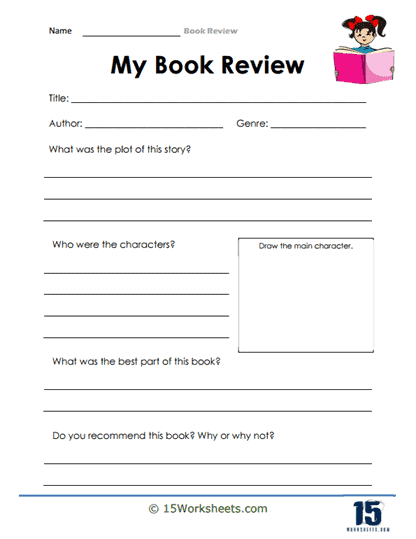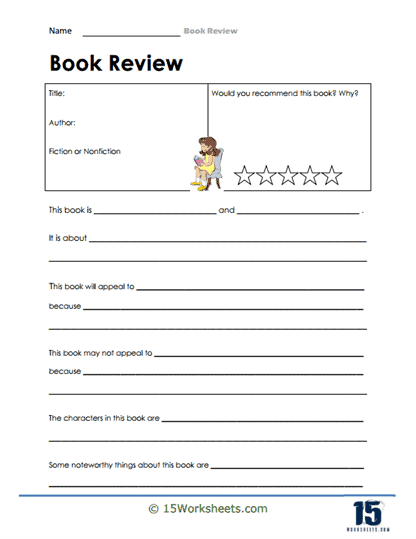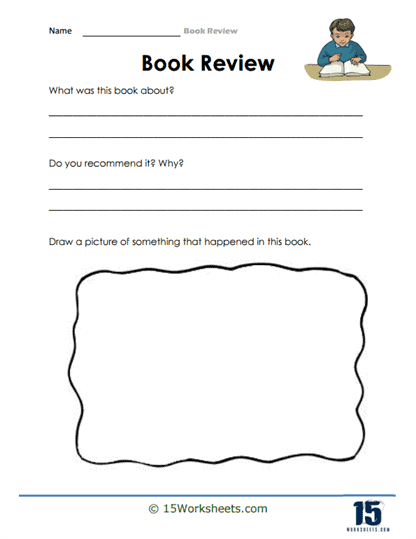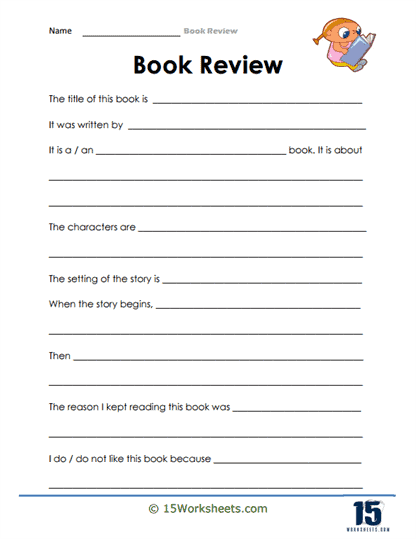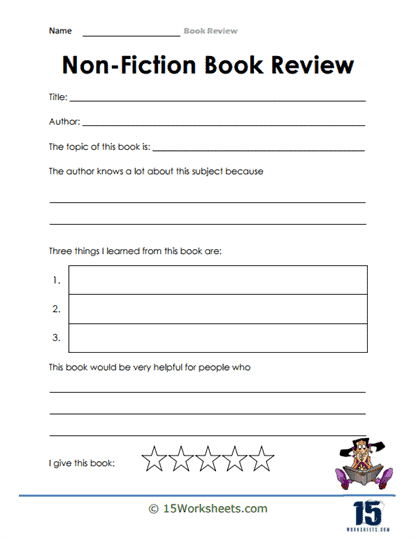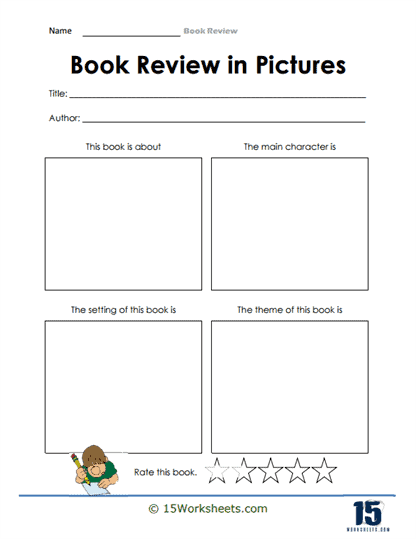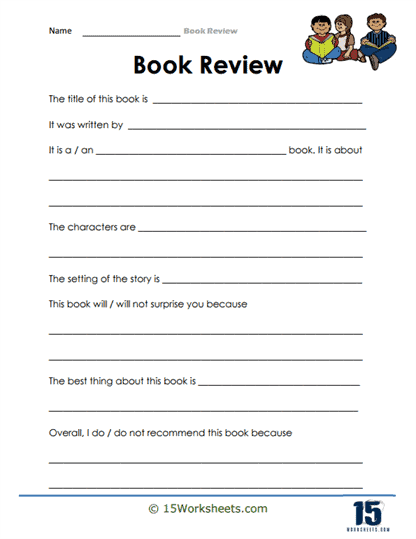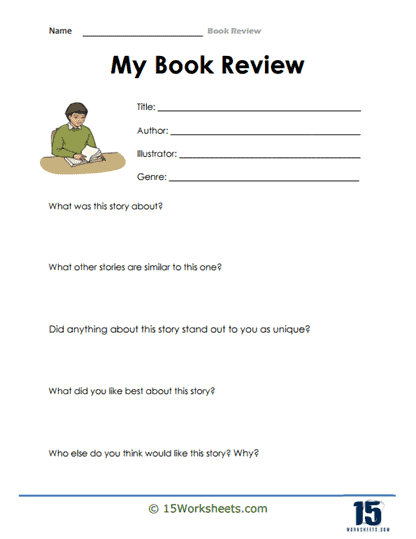Book Review Worksheets
All About These 15 Worksheets
This collection of Book Review worksheets are designed to encourage students to read, analyze, and evaluate books. These worksheets include prompts and questions that help students summarize the book’s plot, identify key themes and characters, and critically evaluate the author’s writing style and message.
The worksheets prompt students to reflect on their own opinions and experiences with the book, asking them to articulate what they liked or didn’t like, and why. This encourages students to develop their critical thinking and analytical skills, as well as their ability to communicate their thoughts and ideas effectively. Through these worksheets, students will:
- Learn how to construct a book review by being guided through writing prompts that ask them to express their own observations and opinions;
- Improve their critical thinking skills and become more discerning readers by rating the books they read and formulating their reasons for recommending or not recommending them;
- Develop their reading comprehension as creating book reviews require them to have a good understanding of the book’s plot, characters, and themes;
- And improve their writing skills as they organize their thoughts and ideas in a clear and concise manner to answer the writing prompts and various activities.
By engaging with books in this way, students can develop a love of reading, improve their writing and analytical skills, and deepen their understanding of the world around them. Moreover, successfully writing a book review can be a rewarding experience for students, as this boosts their confidence and encourages them to take on more challenging writing assignments in the future.
How to Review a Book?
A book review is a critical argument that lets others know your views and opinion regarding a book. Whether you are a literature student or a passionate book blogger, writing a book review is an important skill.
People love to read other people’s opinions regarding their favorite books or books they are planning to buy and read. So you must always give an honest review to let your fellow readers know whether a book will meet up to their expectations or not.
When writing a book review, you must always imagine the reader sitting in front of you, listening to what you have to say regarding the book. You can follow these five stages in writing a book review that is proven to grab your audience’s attention.
1. Hook
A hook is a catchy line or famous quote from the book that would capture the attention of your reader right away. You can also write a compelling one-line sentence that would make your audience keep reading your review instead of skipping it. Make sure you don’t spoil the book or write about the major plot twist.
Taking the example of the most beloved book by Jane Austen, Pride and Prejudice, you can write the first line as a hook, if it is famous and exciting, like “It is a truth universally acknowledged, that a single man in possession of a good fortune, must be in want of a wife.”
Or you can add any other quote that describes the story’s plot. E.g., “I could easily forgive his pride, if he had not mortified mine.”
2. Write About the Main Subject of the Book
The title and author information of the book is important, but in addition to that, you must talk about the genre and general themes of the book. Your audience must know what kind of book they are reading.
There is nothing more frustrating than picking up a book with a title like “To kill a mockingbird” and then reading it to find out it has nothing to do with birds and everything to do with racial injustice, rights and wrongs in a small town, and a defense lawyer raising two kids by himself.
3. Summary
Share a short synopsis or a summary of the plot of the book. It should let the readers know what they are getting into. Talk about the main characters, the major conflict, a little bit about the plot and setting, and make sure you leave out the plot twist and the book’s climax.
Add an exciting cliffhanger at the end of your summary, giving your readers just the right bait to read it but withholding the big mystery which would compel them to read the book.
Take a look at this blurb for the book Stardust by Neil Gaiman.
“To win the heart of his beautiful Victoria, Tristran Thorn would go to any lengths, even as far as entering the unexplored and dark lands on the other side of the ancient wall to retrieve a fallen star. Once he is beyond that cold stone wall, Tristran learns how nothing can be trusted, not even the beautiful and exhilarating Faerie.”
4. Praise and Critique
Your personal opinion, likes, and dislikes set your book review apart from the others. If your reading choices and preferences resonate with your audience, they will be interested in listening to what you have to say regarding the book.
Sharing your review as a reader would let others decide whether they would enjoy reading the book or not, for example.
“Daphne Du Maurier so passionately described the confidence and strong presence of Rebecca that even I, as a reader, felt intimidated by her, all the while admiring her too.”
5. Your Recommendation and Ratings
Summarize your review by recommending the book to your readers. You can rate the book if you want and let others know that if they are interested in a particular genre of books, they will enjoy this book as well.
Let your readers know that all the opinions stated are your own, and the rating you have given the book is based upon your perception of the book.
Before posting your book review, proofread it to eliminate any grammatical errors. Keep your reviews short and streamlined to ensure every word has weight. Get your point across without causing any confusion, and most importantly, do not write mean or dishonest reviews criticizing a good book when it is not required at all.
How Are Books Reviewed?
Books can be reviewed in various ways, depending on the reviewer’s purpose, audience, and platform. Here are some common types of book reviews.
- Professional reviews: These reviews are written by professional book critics and journalists for newspapers, magazines, and online publications. They typically follow a specific format, including a summary of the book’s content, analysis of the author’s writing style, and an evaluation of the book’s strengths and weaknesses.
- Academic reviews: Scholars and subject matter experts write these reviews for academic journals, focusing on the book’s contributions to a particular field of study. They provide a detailed analysis of the book’s argument, methodology, and use of evidence, and often compare it to other works in the field.
- Blog and website reviews: Many bloggers and website owners write book reviews as part of their online content. These reviews can vary in length and style, from informal and personal reflections to more structured evaluations.
- Peer reviews: In some cases, authors may seek feedback from their peers before publication. These reviews can help identify strengths and weaknesses in a manuscript and suggest improvements to make the work more rigorous and engaging.
- Reader reviews: Readers often share their thoughts on books through various platforms like Goodreads, Amazon, and other online retailers. These reviews can be brief or lengthy and may focus on personal impressions, emotional responses, or recommendations for other readers.
- Social media reviews: Many people share their thoughts on books through social media platforms like Facebook, Twitter, and Instagram. These reviews are usually short, informal, and may include images or hashtags to emphasize key points.
- Book club discussions: Book clubs provide a forum for readers to discuss and review books in a group setting. Participants share their opinions, ask questions, and engage in lively conversations about the book’s themes, characters, and plot.
- Video reviews: Booktubers and other content creators on platforms like YouTube and TikTok create video reviews that can include visual elements, author interviews, and even dramatic reenactments of key scenes.
- Podcast reviews: Some podcasts are dedicated to discussing and reviewing books, offering listeners an in-depth exploration of a book’s themes, characters, and writing style, often in a conversational format.
- Interviews and author discussions: Sometimes, reviews can take the form of interviews with the author or panel discussions at book events, where the book’s content, themes, and intentions are discussed in detail.

